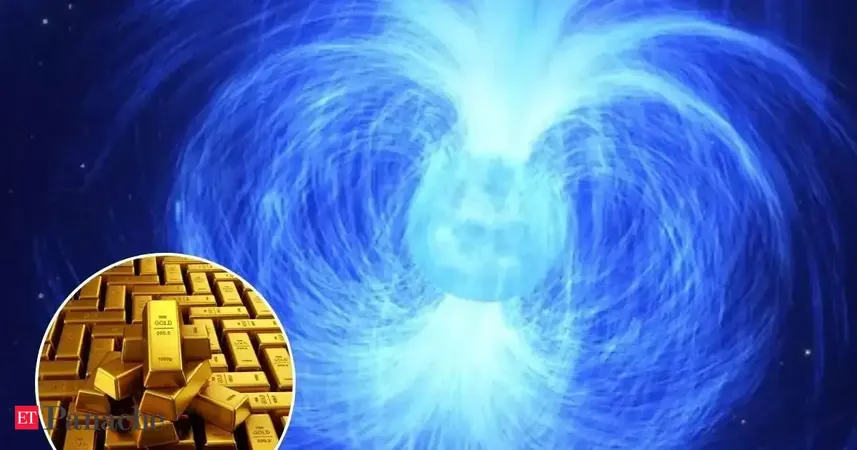
Could Magnetars Be the Key to Unveiling the Universe's Gold Mines?
2025-05-04
Author: Wei Ling
A Shocking Discovery in Cosmic Gold Formation
Scientists are buzzing with excitement over a groundbreaking revelation: magnetars—super-magnetic neutron stars unleashing colossal flares—might be the universe's latest gold factories. A reevaluation of a 2004 gamma-ray signal suggests that these ancient stars, through a phenomenon called 'starquakes,' could forge heavy elements like gold, shaking the very foundations of our cosmic understanding.
Gold has always been a cosmic enigma. While lighter elements such as hydrogen and helium were born in the Big Bang, and heavier elements like iron are produced in stellar explosions, the origins of gold have remained a mystery. Previously, it was thought that the only sources of this precious metal were the catastrophic collisions of neutron stars.
Magnetars: The New Supernova?
According to a CNN report, a recent study has cracked open this cosmic cold case with electrifying implications: gold might arise from the powerful flares of magnetars, whose magnetic fields are a staggering quadrillion times stronger than Earth's. This discovery could revolutionize our understanding of how elements are forged in the universe.
The breakthrough originated from a renewed analysis of data collected nearly two decades ago. Researchers revisited a gamma-ray burst from 2004, linking it closely to theoretical models of a magnetar explosion. These models posit that when a magnetar experiences a 'starquake'—akin to an earthquake on a star's crust—it can launch crust material into space at incredible speeds, potentially containing the building blocks of gold.
Starquakes: Nature’s Goldsmiths?
Eric Burns, an astrophysicist and co-author of the study, elaborated, "We believe that starquakes on magnetars produce brief, intense bursts of X-rays. In some cases, these flares are monumental enough to eject a portion of the star’s surface, which might just provide the necessary conditions for gold formation." This concept, as improbable as it sounds, suggests that everyday gold used in our electronics might have origins in cataclysmic cosmic events.
A Glimpse into Cosmic Archaeology
The 2004 event, previously overlooked, has emerged as a golden lead. By comparing the ancient gamma-ray signal with current predictions, researchers discovered uncanny similarities, supporting the theory that this flare could showcase the birth of heavy elements.
Lead author Anirudh Patel describes the moment of discovery as akin to finding a hidden treasure, stating, "When analyzing our models, we had no idea the signal had been right under our noses all this time. It's astounding to think that gold could have formed from such an ancient cosmic explosion."
Caution Before Celebration
However, not all scientists are convinced. Dr. Eleonora Troja, an expert on neutron star collisions, cautioned that magnetars are chaotic environments. While they may create conditions for heavy elements, they could also yield lighter metals like silver. She emphasized that the production of gold requires specific cosmic ingredients, which may not always be present.
The Future of Cosmic Gold Hunting
To definitively determine if magnetars are indeed responsible for generating gold, scientists will need more than just archival data. NASA's upcoming Compton Spectrometer and Imager (COSI), set to launch in 2027, will play a crucial role. By detecting gamma rays from these cosmic phenomena, COSI aims to directly observe magnetar flares and search for the chemical signatures of heavy elements.
Until then, the question lingers: are these explosive giants silently churning out gold as they rumble across the cosmos? One thing is for certain—the pursuit of answers in the quest for celestial gold is far from over, and the universe may be concealing its treasures within the most violent of realms.




 Brasil (PT)
Brasil (PT)
 Canada (EN)
Canada (EN)
 Chile (ES)
Chile (ES)
 Česko (CS)
Česko (CS)
 대한민국 (KO)
대한민국 (KO)
 España (ES)
España (ES)
 France (FR)
France (FR)
 Hong Kong (EN)
Hong Kong (EN)
 Italia (IT)
Italia (IT)
 日本 (JA)
日本 (JA)
 Magyarország (HU)
Magyarország (HU)
 Norge (NO)
Norge (NO)
 Polska (PL)
Polska (PL)
 Schweiz (DE)
Schweiz (DE)
 Singapore (EN)
Singapore (EN)
 Sverige (SV)
Sverige (SV)
 Suomi (FI)
Suomi (FI)
 Türkiye (TR)
Türkiye (TR)
 الإمارات العربية المتحدة (AR)
الإمارات العربية المتحدة (AR)